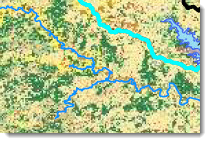by Ernest To* – RPS Espey, Carissa Belsky – Crespo Consulting Services, Inc., David Harkins – RPS Espey,
Jim Patek – Parsons Corporation, Steve Stecher – Crespo Consulting Services, Inc., Mel Vargas – Parsons Corporation,
Jennifer Walker – Watearth, Inc.
* =corresponding author
 Sedimentation in Texas reservoirs is a significant problem that affects both water availability and quality in Texas. The Texas Water Development Board estimates that Texas’ major reservoirs are losing 90,000 acre-feet per year due to sedimentation. This is equivalent to a loss of 4.5 million acre-feet by 2060 and exceeds the projected increase of 3.4 million acre-feet from new reservoirs. The reduction in storage volume not only impacts water supply but also necessitates the alteration of supply infrastructure to handle deteriorating water quality. Uncertainty regarding rainfall supply due to climate change further burdens the already stressed reservoirs.
Sedimentation in Texas reservoirs is a significant problem that affects both water availability and quality in Texas. The Texas Water Development Board estimates that Texas’ major reservoirs are losing 90,000 acre-feet per year due to sedimentation. This is equivalent to a loss of 4.5 million acre-feet by 2060 and exceeds the projected increase of 3.4 million acre-feet from new reservoirs. The reduction in storage volume not only impacts water supply but also necessitates the alteration of supply infrastructure to handle deteriorating water quality. Uncertainty regarding rainfall supply due to climate change further burdens the already stressed reservoirs.

Figure 1: Major reservoirs in the State of Texas.
Approach
A statewide study was conducted for the Texas Water Development Board to assemble the data and tools needed to identify the reservoirs that are most at-risk for sedimentation in Texas. This study involved substantial use of EPA’s NHDPlus dataset to delineate and characterize watersheds for almost two hundred major reservoirs in Texas.
Apart from spatial data, NHDPlus also contains a lot of data associated with erosion and sedimentation in its value-added attribute tables. These include land use and land cover information (related to watershed erosion), stream length and order (channel erosion), and, elevation and precipitation (slope and runoff), etc.

Figure 2: Watersheds for Texas reservoirs delineated using NHDPlus.
Maps
After extracting the relevant information from NHDPlus, maps were created for each of the 190+ major reservoirs in Texas to summarize the associated sediment-related data. These include information on watershed area, slope, soil erodibility, stream length, stream density, precipitation, temperature, reservoir area, volume, residence time and shoreline development index.

Figure 3: A data summary map developed for Lake Travis near Austin, TX.
Decision Support Tool
The sediment related data were incorporated into a versatile decision support system (DSS). This decision support system is a software tool that allows users to assign weights for each category of sedimentation data. These weights were later used to score the reservoirs.

Figure 4: Assignment of weights for the ranking of reservoirs at risk for sedimentation.
The scores were ranked to identify the most at-risk reservoirs for further studies and watershed protection planning.

Figure 5: Reservoirs in Texas ranked by sedimentation risk.
Conclusions
This study compiled data from many sources to help stakeholders identify which reservoirs are most at-risk for sedimentation. Apart from the NHDPlus data and the DSS tool described above, a substantive compilation of available empirical sedimentation rates was also performed. In addition, a Best Management Practices matrix that lists commonly-used landscape-based structural BMPs was created. Together, these set of tools and databases can help users identify sedimentation risks as well as methods to address them at a planning level.
Acknowledgements
 This study was completed with funding from the Texas Water Development Board (TWDB contract #: 1004831120). The authors would like to thank Dr. Ruben Solis and Dr. Yujuin Yang from the Texas Water Development Board for their guidance in this study.
This study was completed with funding from the Texas Water Development Board (TWDB contract #: 1004831120). The authors would like to thank Dr. Ruben Solis and Dr. Yujuin Yang from the Texas Water Development Board for their guidance in this study.

Article Discussion: